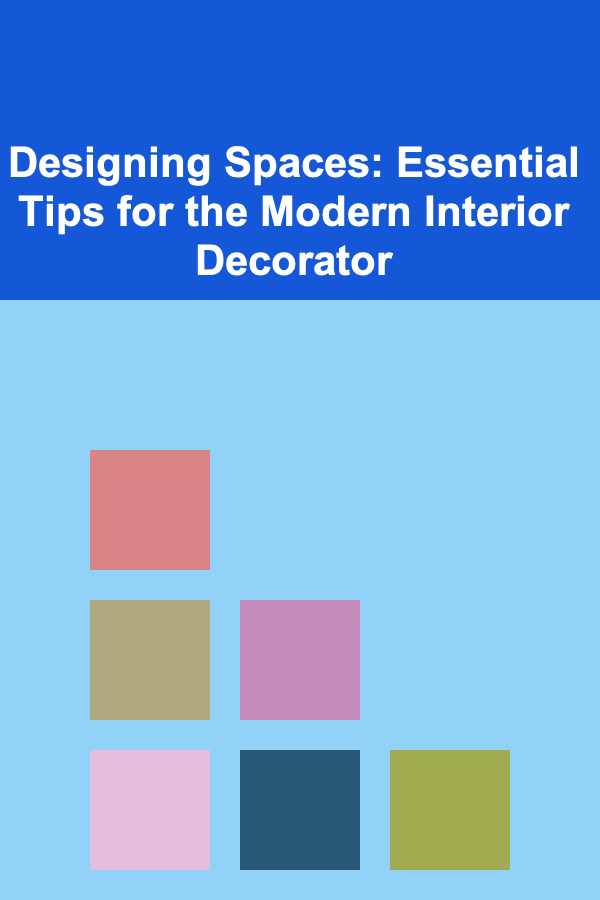
Designing Spaces: Essential Tips for the Modern Interior Decorator
ebook include PDF & Audio bundle (Micro Guide)
$12.99$5.99
Limited Time Offer! Order within the next:

Designing an interior space is both an art and a science. As a modern interior decorator, it's essential to balance creativity with practicality. With the right approach, you can create spaces that are not only aesthetically appealing but also functional, sustainable, and a true reflection of the people who inhabit them. In this actionable guide, we will dive into the essential aspects of interior design, offering deep insights and practical advice that can help you design beautiful, cohesive, and functional spaces.
Understand the Purpose of the Space
Before diving into color palettes, furniture, and decorations, the first step in designing any space is understanding its purpose. The design of a room should support its intended function, whether it's a living room, office, bedroom, or kitchen.
- Functionality First: A space's functionality is paramount. How will the room be used on a daily basis? In a living room, comfort and social engagement are key, so it's important to select pieces that allow for conversation and relaxation. In an office, ergonomics and productivity should be prioritized, while in a kitchen, efficient workflows should be the primary focus.
- Adaptability: Rooms may evolve over time, so think long-term. A nursery might one day be a study, or a playroom might become a guest room. Choose versatile, adaptable furniture that can serve multiple functions.
- Design Around Users: Think about who will be using the space. Families, singles, young professionals, or retirees will all have different needs. Consider age, lifestyle, and the specific needs of the individuals using the space. For example, children's rooms should have durable, easy-to-clean materials, while a minimalist space for a young professional might focus on sleek, modern design elements.
Develop a Clear Design Concept
A well-executed design stems from a unified vision or concept. This concept should guide every design decision, ensuring consistency and cohesiveness throughout the space.
- Color Palettes: The color scheme you choose will dramatically impact the mood and atmosphere of the space. Lighter colors can make a room feel larger and more open, while darker hues create a cozy, intimate feeling. Experiment with different tones to find what resonates with the vibe you're trying to create. When selecting a color palette, think about natural light. A room that gets a lot of sunlight will benefit from cooler tones, while darker rooms might need warmer colors to make them feel welcoming.
- Textures and Materials: The mix of textures---soft fabrics, hard metals, rough woods, smooth glass---can significantly impact the tactile and visual appeal of a space. A mix of materials adds depth and interest to the design. For instance, combine plush cushions and throws with sleek metal furniture or wooden accents to achieve a balanced, multi-dimensional look.
- Style Consistency: While it's tempting to incorporate elements from various design styles, consistency is key. Whether you prefer a minimalist, industrial, mid-century modern, or eclectic design, sticking to a consistent style throughout the room (or home) will create harmony. Mixing too many styles or eras can create visual chaos. Identify your core design style and stay true to it.
Functionality and Practicality Are Essential
Great design is not just about making a room look good; it's about making it work well. As you design, it's important to focus on the practical aspects of how the space functions.
- Smart Furniture Choices: Choose furniture that serves a dual purpose. Multi-functional pieces such as a sofa that can transform into a bed, or an ottoman that doubles as a storage unit, are incredibly useful. A dining table that extends for larger gatherings or a coffee table with built-in storage can help maximize the space. It's essential that every piece of furniture serves a functional purpose without compromising aesthetics.
- Maximize Storage: Clutter can ruin the ambiance of any well-decorated room. Incorporating clever storage solutions ensures a tidy and organized space. Look for hidden storage options, such as under-bed drawers, built-in shelves, or cabinets that blend seamlessly into the walls. If possible, integrate storage into your design to keep the space feeling open and clean.
- Ergonomics: Especially in spaces where people spend a lot of time, such as home offices or living rooms, ergonomic design is essential. Comfortable seating, desk height adjustments, and the correct arrangement of furniture can make a significant difference in how users experience the space. Consider the comfort and accessibility of furniture for all users, ensuring it supports their daily tasks without strain.
- Smart Lighting: Lighting is one of the most critical aspects of design, influencing the mood and functionality of a space. Layer your lighting by incorporating ambient, task, and accent lights. Ambient lighting provides overall illumination, task lighting focuses on specific activities (like reading or cooking), and accent lighting highlights features or artwork. Use dimmers and smart lighting systems to control the mood and functionality of the room easily.
Personalize the Space
The best spaces reflect the personalities and lifestyles of their inhabitants. Personalization helps make the space feel truly lived in, comfortable, and unique.
- Incorporate Artwork: Art gives a room character and soul. Whether it's a painting, a photograph, or a sculpture, artwork can make a space feel more personal and engaging. Don't be afraid to mix styles---modern art can work beautifully in a traditional room, and vintage artwork can add warmth to a minimalist space.
- Add Unique Elements: Mix old and new pieces for a curated, eclectic look. A vintage armchair might complement a contemporary coffee table, creating an intriguing contrast. This mixture of styles not only adds interest but also tells a story about the people who live there.
- Use Personal Items: Incorporating personal items, such as family heirlooms, travel souvenirs, or treasured objects, creates an intimate atmosphere. These items give the space a sense of history and meaning. For instance, a collection of books, a favorite rug, or a piece of handmade pottery can all serve as focal points.
- Indoor Plants: Adding plants to your space isn't just an aesthetic decision---they improve air quality and can make the space feel more alive. From large statement plants like fiddle leaf figs to small potted succulents, plants are an easy way to introduce a touch of nature indoors. Consider the amount of natural light the space receives when selecting plants, and opt for low-maintenance varieties if you're not confident in your green thumb.
Pay Attention to the Details
The beauty of interior design often lies in the smallest details. These finishing touches elevate the space and give it a sense of completeness.
- Hardware and Fixtures: Updating hardware like door handles, cabinet knobs, and faucets can have a transformative effect. Whether you go for sleek, modern finishes like matte black or brass or more traditional options like chrome or brushed nickel, the right hardware adds polish to the design.
- Mirrors and Reflective Surfaces: Mirrors are a designer's secret weapon for creating the illusion of space and light. Strategically placed mirrors can open up small rooms, reflect natural light, and make a space feel brighter. Consider mirrored furniture, or even mirrored accents in decor pieces, to add a touch of luxury and sophistication.
- Layering and Textures: Layering is essential to creating a dynamic and inviting room. Mix and match textures through fabrics, rugs, and throw pillows to create warmth and comfort. For example, you might pair a soft wool rug with a sleek leather sofa and a linen throw pillow for contrast.
- Functional Accessories: Accessories should serve both practical and decorative purposes. Choose stylish yet functional items like elegant trays, baskets for storage, or decorative bowls that add texture and interest. Small details like stylish coasters, a beautiful clock, or designer lighting fixtures can make all the difference in creating a cohesive and polished look.
Sustainability and Longevity in Design
In the modern world, sustainable and eco-friendly design practices are more important than ever. As a designer, you have the responsibility to consider the environmental impact of your choices.
- Sustainable Materials: Opt for materials that are renewable, recyclable, and ethically sourced. Wood from responsibly managed forests, recycled glass, and organic textiles (like linen or cotton) are all excellent choices. Reclaimed wood furniture or vintage pieces not only adds character but also reduces waste.
- Durable Furnishings: Choose high-quality, durable furniture that will stand the test of time. While it may be tempting to opt for cheaper, fast-fashion items, investing in well-made pieces ensures the longevity of the design and reduces the need for frequent replacements.
- Energy Efficiency: When designing a space, consider energy-efficient appliances, LED lighting, and well-insulated windows. Sustainable design extends beyond furniture---it's about creating a space that reduces its environmental impact while enhancing the quality of life for its inhabitants.
Conclusion
Designing a space is a multi-faceted process that requires attention to detail, creativity, and a deep understanding of functionality. By focusing on purpose, developing a cohesive design concept, balancing beauty with practicality, and personalizing the space, you can create environments that are both beautiful and livable. Don't forget to consider sustainability and the longevity of your design choices. Ultimately, the goal of an interior decorator is not only to create stunning spaces but also to design environments that support and enhance the lives of the people who occupy them.

How to Build Strong Relationships with Your Dropshipping Suppliers
Read More
How to Render Bacon Fat for Cooking
Read More
How to Renovate Your Home for Better Storage Solutions
Read More
How to Stage Your Home's Garage to Maximize Appeal
Read More
How to Start a Family Scrapbooking Project Together
Read More
How to Use Shade Cloth for Plant Protection and Organization
Read MoreOther Products

How to Build Strong Relationships with Your Dropshipping Suppliers
Read More
How to Render Bacon Fat for Cooking
Read More
How to Renovate Your Home for Better Storage Solutions
Read More
How to Stage Your Home's Garage to Maximize Appeal
Read More
How to Start a Family Scrapbooking Project Together
Read More